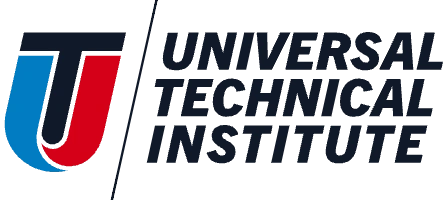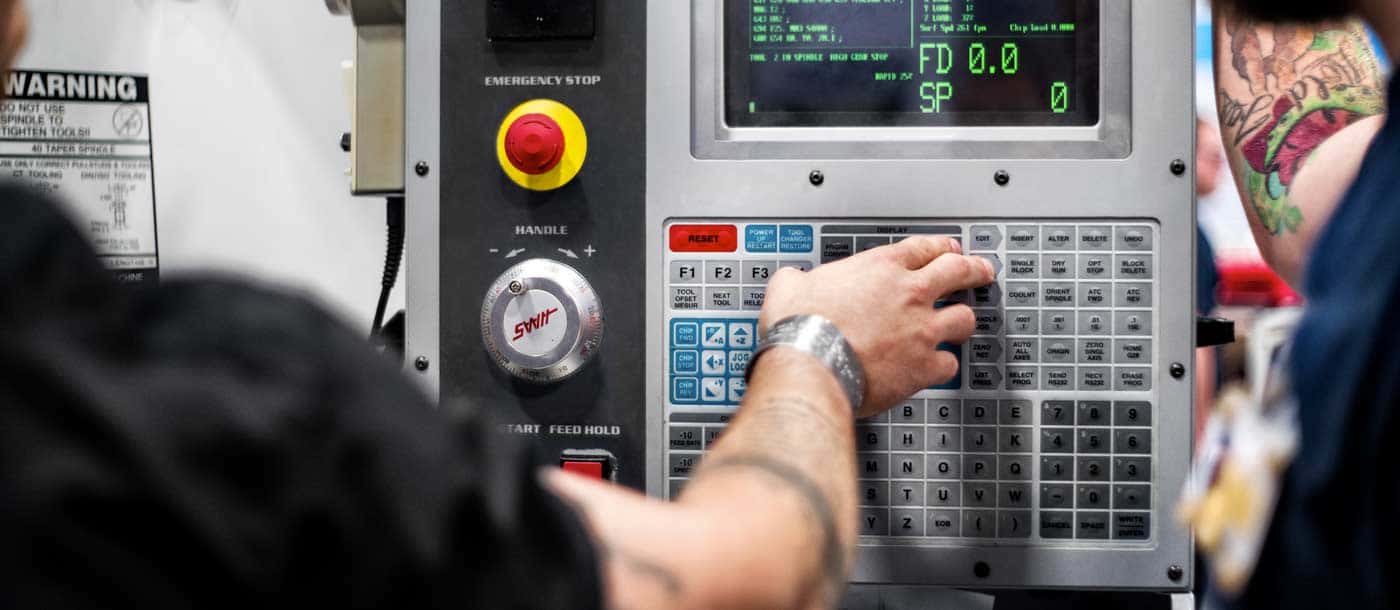An Inside Look at UTI’s CNC Classes
Ever wondered what you’ll learn in a CNC machine course?
As a student in Universal Technical Institute’s CNC Machining Technology program offered in Mooresville, North Carolina, you’ll be taught basic machine shop skills, how to interpret blueprints, advanced manual milling operations and everything in between.
By the end of this 36-week program, graduates will possess valuable knowledge and skills to start pursuing a career in the CNC industry.1
Before beginning any type of CNC machining training, it can be helpful to research the program classes so you have an idea of what to expect. Keep reading to find out what you’ll be taught in each CNC machine course at UTI:
Basic Machine Shop Skills
In this introductory course, you will be taught to safely operate equipment in a machining environment. You’ll also be taught about hand tools, saw types, saw blades, installation and removal, and welding. This course primarily focuses on the proper care and use of semi-precision measuring equipment.
The machining industry requires daily use of mathematics. In this course, you will be taught to demonstrate proficiency using fractions, and use mathematics, precision measuring equipment and proper workpiece layout for manual machining. You will also be introduced to the use of hand tools on a drill press.
Key takeaways
- How to operate equipment and work safely in a machining environment
- Proper care and use of various tools and semi-precision measuring equipment
- How to utilize and apply mathematical concepts that relate to the CNC industry
Tools & technology used
- Drill presses, vertical and horizontal band saws, grinders, manual lathes, manual mills and CNC turning and machining centers
- Semi-precision measuring equipment such as rulers, calipers, adjustable squares, combination sets, protractors, bevels, surface plates and gage blocks
Mathematics, Materials and Maintenance
You will be taught about ferrous and nonferrous material compositions and heat-treatment methods in this course. You’ll also be taught about various material hardness-testing methods and measurement scales.
In order to improve your mathematical skills, you will demonstrate proficiency in algebraic calculations, as well as calculating ratios and proportions. Additionally, you’ll be taught about the use of precision measuring equipment and how to maintain machines in a machine shop by learning why and when to perform periodic maintenance.
Key takeaways
- Basics of ferrous and nonferrous material compositions, heat-treatment methods, material hardness-testing methods and measurement scales
- How to calculate ratios, proportions and algebraic equations as they relate to the CNC industry
- How to use precision measuring equipment and maintain machines through performing periodic maintenance
Tools & technology used
- Precision measuring equipment such as micrometers and plunge indicators, Rockwell hardness scale and refractometer
Interpreting Blueprints/Job Layout
In this CNC machine course, you will begin reading blueprints to learn about their layout and the information presented. By understanding the parts and their corresponding prints, you’ll gain an understanding of inter-related feature relationships.
You will be taught to use a manual lathe after having learned proper work and toolholding techniques, and you are also introduced to the manual mill. Topics covered include mill-specific cutting tools and toolholding and workholding devices. You will use mathematics, precision measuring equipment and proper workpiece layout for manual machining.
Key takeaways
- Introduction to blueprint reading
- Proper work and toolholding techniques
- Use of manual lathes and mills
- How to use mathematics, precision measuring equipment and proper workpiece layout for manual machining
Tools & technology used
- Manual lathes, vertical milling machines and various benchwork layout equipment, including scribes, layout fluid, combination sets, dividers, trammels, center punches, protractors and calipers
Manual Machining Basics
Topics covered in this CNC machining training course include manual lathe operations and vertical milling setup. You will be taught the skills necessary to ensure proper and accurate use of manual lathe and milling machines to create various part features.
The course concludes with a conversation about offhand grinding equipment, as well as information relating to grinding wheels. You’ll also be taught to safely deburr parts and sharpen cutting tools.
Key takeaways
- Manual lathe operations
- Vertical milling setup
- Introduction to offhand grinding equipment and grinding wheels
- How to safely deburr parts and sharpen cutting tools
Tools & technology used
- Pedestal grinders, manual lathes and milling machines
Manual Machining on the Lathe
You will develop an understanding of manual lathe threading and taper turning in this course. You will also be taught the skills necessary to ensure proper and accurate use of the manual milling machine to create various part features. The course concludes with a conversation on indexing head operations.
Key takeaways
- Manual lathe threading
- Taper turning
- Indexing head operations
Tools & technology used
- Manual lathes and milling machines
Manual Machining on the Mill
In this course, students dive into advanced manual milling operations. You will be taught the skills necessary to ensure proper and accurate use of the manual milling machine to create various part features. Special emphasis is placed on angular milling and complex milling operations, and you will also be taught geometry and trigonometry concepts required to accurately perform these operations.
Key takeaways
- Advanced manual milling operations
- Angular milling
- Geometry and trigonometry for CNC operations
Tools & technology used
- Manual mills
CNC Basics
This course covers the aspects of Computer Numerical Control that apply to both turning and milling operations. Subjects such as automatic tool changers, the machine control unit, motion control, coordinate systems and positioning systems are covered in detail. You will be taught programming concepts such as word addresses, G and M codes and tool movement commands.
Students also are exposed to the structural parts of a CNC program as well as an introduction to conversational programming. You’ll be taught about CNC turning machines, and work and toolholding devices, as well as cutting tools used in CNC turning. Included in this course are in-depth conversations regarding the Continuous Improvement component of quality assurance vs. quality control.
Key takeaways
- Automatic tool changers
- The machine control unit
- Motion control
- Coordinate systems
- Positioning systems
- Programming concepts such as word addresses, G and M codes and tool movement commands
- Introduction to conversational programming
- Quality assurance vs. quality control
Tools & technology used
- Haas control panel simulators
CNC Turning I
Programming for CNC turning applications is the primary focus of this class. Students learn about CNC turning machines, toolholding and workholding devices, as well as cutting tools used in CNC turning.
Utilizing content learned in this class, you will begin writing your own programs. Some of the many subjects covered include tool changes, sequence numbering, program stops, coolant codes and canned cycles, as well as various turning operations. The Continuous Improvement component of buy vs. make analysis concludes the course.
Key takeaways
- Programming for CNC turning applications
- Tool changes
- Sequence numbering
- Program stops
- Coolant codes
- Canned cycles
- Turning operations
- Buy vs. make analysis
Tools & technology used
- Haas control panel simulators
CNC Turning II
This course focuses on the setup and operation of CNC turning centers. You will be taught to utilize control panel buttons, keys, dials and knobs to control the lathe, as well as to load, display, edit and run programs. You’ll also be taught to set up workholding devices and account for coordinate system differences, tool geometry and wear offsets, as well as enter and prove out programs.
At the conclusion of the course, you will run programs at full feed, speed and rapid capabilities through use of auto mode. You’ll also be taught about the Continuous Improvement components of Just in Time and Six SigmaTM.
Key takeaways
- Setup and operation of CNC turning centers
- How to utilize control panel buttons, keys, dials and knobs to control the lathe
- How to load, display, edit and run programs
- How to set up workholding devices and account for coordinate system differences
- How to tool geometry and wear offsets and enter and prove out programs
- How to use auto mode to run programs at full feed, speed and rapid capabilities
Tools & technology used
- CNC turning centers
CNC Milling I
This course begins with an introduction to the various types of milling machines and toolholding types used in milling machines. The course’s primary focus is on programming for CNC mills.
As a student, you will begin writing your own milling programs using the content learned in this class. You will also complete a lab exercise in material resource planning (MRP), which is part of Continuous Improvement.
Key takeaways
- Introduction to various types of milling machines and toolholding types used in milling machines
- Programming for CNC mills
- How to write milling programs
- Material resource planning (MRP)
Tools & technology used
- Haas control panel simulators
CNC Milling II
This course focuses on the setup and operation of CNC milling machines. You will learn to utilize the control panel buttons, keys, dials and knobs to control the mill as well as to load, display, edit and run programs. You’ll also learn to set up workholding devices and account for coordinate system differences, tool geometry and wear offsets, as well as enter and prove out programs.
At the conclusion of the course, you will run programs at full feed, speed and rapid capabilities through the use of auto mode. The course concludes with the Continuous Improvement component of a capacity resource planning lab exercise.
Key takeaways
- Setup and operation of CNC milling machines
- How to utilize the control panel buttons, keys, dials and knobs to control the mill
- How to set up workholding devices and account for coordinate system differences, tool geometry and wear offsets, as well as enter and prove out programs
- How to utilize capacity resource planning
Tools & technology used
- CNC machining centers
CAD and CAM
Through CAD software, you will be taught the different geometry types such as wireframes, solid models and surfaces. Different software types are discussed to aid students in the understanding of CAD/CAM. Through the use of CAM software, you will be taught about toolpaths such as 2D contour milling, face milling, hole making, pocketing, contour turning and 3D milling.
Verification and simulation functions are used to ensure the tool(s) behave as expected and all machining details have been defined. You will be taught about post-processing, a process of permitting the CAM software to write the CNC program. The course concludes with the Continuous Improvement summarization of change management.
Key takeaways
- Introduction to various toolpaths and geometry types such as wireframes, solid models and surfaces
- How to use verification and simulation functions
- How to utilize post-processing
- Change management in a CNC environment
Tools & technology used
- Mastercam software on PCs

